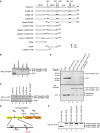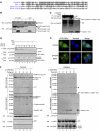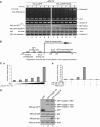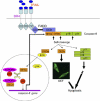Death effector domain DEDa, a self-cleaved product of caspase-8/Mch5, translocates to the nucleus by binding to ERK1/2 and upregulates procaspase-8 expression via a p53-dependent mechanism
- PMID: 17290218
- PMCID: PMC1852837
- DOI: 10.1038/sj.emboj.7601571
Death effector domain DEDa, a self-cleaved product of caspase-8/Mch5, translocates to the nucleus by binding to ERK1/2 and upregulates procaspase-8 expression via a p53-dependent mechanism
Abstract
Activation of the apical caspase-8 is crucial to the extrinsic apoptotic pathway. Although the death effector domain (DED) of caspase-8 has been reported to be involved in death-inducing signaling complex formation, the detailed mechanism of how DED functions in regulating apoptosis remains largely unknown. Here, we demonstrate that the prodomain of the caspase-8/Mch5 can be further cleaved between two tandemly repeated DEDs (DEDa-DEDb) at the amino-acid residue Asp129 by caspase-8 itself. The DEDa fragment generated from the endogenous caspase-8 was detected in isolated nucleoli upon treatment with TRAIL (tumor necrosis factor-related apoptosis-inducing ligand). Cleaved DEDa appears to translocate into the nucleus by association with extracellular signal-regulated protein kinases-1/2 (ERK1/2). Elimination of ERK1/2 expression by RNA interference resulted in a significant attenuation of nuclear entry of DEDa and reduced caspase-8-dependent apoptosis. In the nucleus, DEDa interacts with TOPORS, a p53 and topoisomerase I binding protein, and possibly displaces p53 from TOPORS, allowing p53 to stimulate caspase-8 gene expression. In summary, we postulate a positive feedback loop involving DEDa, which enables the continual replenishment of procaspase-8 during apoptosis.
Figures







Similar articles
-
Destabilization of CARP mRNAs by aloe-emodin contributes to caspase-8-mediated p53-independent apoptosis of human carcinoma cells.J Cell Biochem. 2011 Apr;112(4):1176-91. doi: 10.1002/jcb.23031. J Cell Biochem. 2011. PMID: 21308745
-
topors, a p53 and topoisomerase I-binding RING finger protein, is a coactivator of p53 in growth suppression induced by DNA damage.Oncogene. 2005 May 12;24(21):3385-96. doi: 10.1038/sj.onc.1208554. Oncogene. 2005. PMID: 15735665
-
Topors acts as a SUMO-1 E3 ligase for p53 in vitro and in vivo.FEBS Lett. 2005 Sep 12;579(22):5007-12. doi: 10.1016/j.febslet.2005.07.088. FEBS Lett. 2005. PMID: 16122737
-
The death effector domain protein family: regulators of cellular homeostasis.Nat Immunol. 2003 May;4(5):404-9. doi: 10.1038/ni0503-404. Nat Immunol. 2003. PMID: 12719729 Review.
-
Are promyelocytic leukaemia protein nuclear bodies a scaffold for caspase-2 programmed cell death?Trends Biochem Sci. 2007 Sep;32(9):400-6. doi: 10.1016/j.tibs.2007.08.001. Epub 2007 Aug 10. Trends Biochem Sci. 2007. PMID: 17693089 Review.
Cited by
-
Crystal structure and functional characterization of the human RBM25 PWI domain and its flanking basic region.Biochem J. 2013 Feb 15;450(1):85-94. doi: 10.1042/BJ20121382. Biochem J. 2013. PMID: 23190262 Free PMC article.
-
Inhibition of PDGF-B induction and cell growth by syndecan-1 involves the ubiquitin and SUMO-1 ligase, Topors.PLoS One. 2012;7(8):e43701. doi: 10.1371/journal.pone.0043701. Epub 2012 Aug 17. PLoS One. 2012. PMID: 22912899 Free PMC article.
-
Dysfunctional HIV-specific CD8+ T cell proliferation is associated with increased caspase-8 activity and mediated by necroptosis.Immunity. 2014 Dec 18;41(6):1001-12. doi: 10.1016/j.immuni.2014.12.011. Epub 2014 Dec 8. Immunity. 2014. PMID: 25526311 Free PMC article.
-
Single-nucleotide polymorphisms in the p53 signaling pathway.Cold Spring Harb Perspect Biol. 2010 May;2(5):a001032. doi: 10.1101/cshperspect.a001032. Epub 2009 Dec 9. Cold Spring Harb Perspect Biol. 2010. PMID: 20452958 Free PMC article. Review.
-
Raloxifene inhibits tumor growth and lymph node metastasis in a xenograft model of metastatic mammary cancer.BMC Cancer. 2010 Oct 19;10:566. doi: 10.1186/1471-2407-10-566. BMC Cancer. 2010. PMID: 20958960 Free PMC article.
References
-
- Andersen JS, Lyon CE, Fox AH, Leung AK, Lam YW, Steen H, Mann M, Lamond AI (2002) Directed proteomic analysis of the human nucleolus. Curr Biol 12: 1–11 - PubMed
-
- Banelli B, Casciano I, Croce M, Di Vinci A, Gelvi I, Pagnan G, Brignole C, Allemanni G, Ferrini S, Ponzoni M, Romani M (2002) Expression and methylation of CASP8 in neuroblastoma: identification of a promoter region. Nat Med 8: 1333–1335 - PubMed
-
- Barnhart BC, Lee JC, Alappat EC, Peter ME (2003) The death effector domain protein family. Oncogene 22: 8634–8644 - PubMed
-
- Boatright KM, Renatus M, Scott FL, Sperandio S, Shin H, Pedersen IM, Ricci JE, Edris WA, Sutherlin DP, Green DR, Salvesen GS (2003) A unified model for apical caspase activation. Mol Cell 11: 529–541 - PubMed
-
- Boldin MP, Goncharov TM, Goltsev YV, Wallach D (1996) Involvement of MACH, a novel MORT1/FADD-interacting protease, in Fas/APO-1- and TNF receptor-induced cell death. Cell 85: 803–815 - PubMed
Publication types
MeSH terms
Substances
LinkOut - more resources
Full Text Sources
Molecular Biology Databases
Research Materials
Miscellaneous

